|
We have changed the plan for next summer’s Niku IX expedition. Instead of using manned submersibles to search the ocean reef slope for remains of the Earhart Electra, we’ll search the lagoon for wreckage that washed in through the main passage.
The Pisces subs of the Hawai’i Undersea Research Laboratory (HURL) are still the best way to do a thorough examination of the reef slope, but the more we learn about the probable fate of the airplane, the less likely it seems that such a search would be successful. The evidence now points to the airplane having broken up in the surf. Surviving components on the reef slope are likely to be small, and embedded – or even covered – in coral, difficult if not impossible to find. At the same time, despite our best efforts, we have been unable to find sponsors willing to cover the $1,750,000 cost of a reef search.
For the new Niku IX we’ll add a lagoon search to the 2017 Betchart Expeditions cruise already scheduled to be at Nikumaroro for eight days – from June 28 to July 5, 2017. So far, about 40 passengers are signed up to participate in land-based searching guided by TIGHAR Senior Archaeologist Dr. Tom King and a staff of experienced TIGHARs. If we can raise $250,000 (14% of the previous goal) Executive Director Ric Gillespie and a highly-qualified lagoon search team will join the expedition.

M/V Reef Endeavor is a 240 ft, 3,125 ton luxury cruise ship. She can accommodate up to 130 passengers so there is plenty of room for TIGHAR members who would like to join the expedition. Cabins start at $8,995. The trip departs from Los Angeles to Fiji on June 21 and returns on July 11. For details and to make your reservation go to Betchart Expeditions.
Why the Lagoon?
Searching the lagoon, although not without its own challenges, is far more economical, safer, and arguably more likely to produce identifiable Electra components. We know that debris on the reef washes into the lagoon and we have several anecdotal accounts of aircraft wreckage seen in, or possibly on its way into, the lagoon.
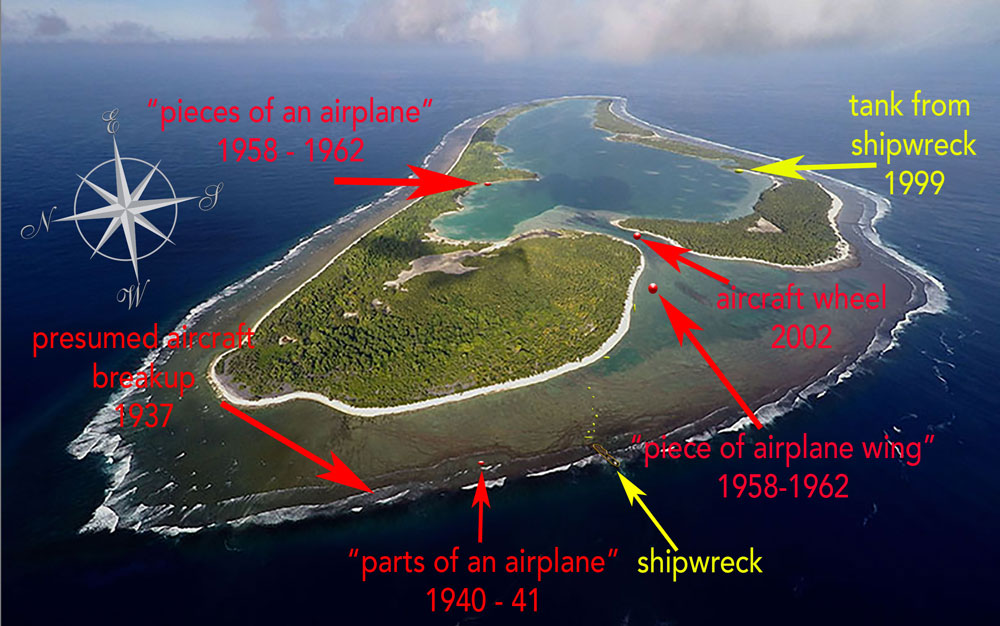
Shipwreck Debris
| Severe weather at Nikumaroro comes out of the west and northwest. Debris from the wreck of SS Norwich City is distributed southeastward toward the main lagoon passage. Buoyant objects are carried into the lagoon by wind and waves. A large steel tank from the wreck appeared on the lagoon shore about a mile from the passage some time between 1985 and 1999 (most likely during tropical cyclones that hit the island in January/February 1990). By 2011 it was gone, either driven back into the bush (although nothing is apparent in satellite imagery) or floated back out into the lagoon to sink or be washed ashore elsewhere. The lesson is that debris distribution at Nikumaroro is not a one-time event. Objects from the reef, and conceivably from the ocean, enter the lagoon via the main passage in heavy weather and continue to be influenced by subsequent storms.
The steel tank from the shipwreck was roughly four feet tall by about ten feet long and probably weighed at least half a ton.
|
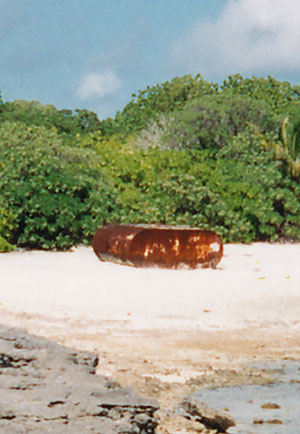
|
The Wheel of Fortune
In 2002, marine biologist Dr. Greg Stone, was at Nikumaroro with a team from the New England Aquarium to study the reef. Walking along the shore of the main passage, he saw an object in shallow water that he took to be an airplane wheel. He tried to pick it up but it was stuck to the bottom. He didn’t take a photo because the object was so obvious he assumed that TIGHAR had already checked it out.
When he later learned that we were not aware of the wheel, Greg Stone met Ric Gillespie at the New England Air Museum in Windsor Locks, CT to look at airplane wheels and see if anything resembled what he saw. The wheel that looked right was on the museum’s Lockheed Electra.
TIGHAR sent a small team to Nikumaroro the next year to recover what we dubbed the Wheel of Fortune, but when they arrived the team saw that the shore of the main passage had recently suffered severe damage and overwash. The wheel was gone, presumably washed into the lagoon by the storm. |
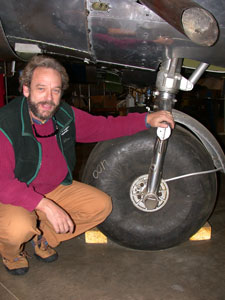
|
“Pieces of an Airplane” Returning from the storm-tossed 1997 Niku III expedition we were stranded in Funafuti for six days. While there, purely by coincidence, we connected with some people who had lived on Nikumaroro. Risasi Finikaso had been born on the island in 1959 and so was only four years old when the settlement was abandoned in 1963, but her friend, Tapania Taeke, was eight years old when her family left Nikumaroro in 1962. She remembered seeing “a piece of an airplane wing” on the reef about halfway between the shipwreck and the main passage. The object was dull silver/gray in color and roughly four feet wide by nine feet long. Her father, Pulekai Songivalu, had been the schoolmaster on Nikumaroro from 1958 until his departure in 1962 at age thirty-five. He told of seeing “pieces of an airplane” on the lagoon shore opposite the main passage. He assumed the debris was from a WWII wreck (no aircraft were lost at Nikumaroro during WWII). He said people from the village used the metal “to make plates and other things.” |
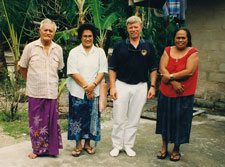 Left to right: Pulekai Songivalu, Risasi Finikaso, Ric Gillespie, Tapania Taeke. In Fongafala, Funafuti, 1997. |
“Parts of an Airplane”
In 1999 we interviewed Emily Sikuli in Fiji. She was the daughter of the island carpenter and lived on Nikumaroro as a teenager in the early years of the settlement from January 1940 until November 1941. Her father made the coffin in which the bones of the castaway were transported to Fiji. She told us he had pointed out to her parts of an airplane at the reef edge just north of the shipwreck.
Emily Sikuli
That objects on the reef wash into the lagoon is beyond question, but all of the sightings of airplane debris are anecdotal and therefore inherently unreliable absent contemporary written or photographic documentation. On the other hand, with the exception of the father and daughter on Funafuti, the witnesses were unknown to each other and their respective sightings are widely separated in time. Many components in Earhart’s Electra were buoyant, such as fuel and oil tanks, or attached to the aircraft’s wooden flooring. There would appear to be an excellent chance that there are now airplane parts in the lagoon.
Finding them presents some challenges. The lagoon bottom is hard sand covered with a few inches of fine silt except in the delta of the main passage and in a few coves along the shore where the silk is several feet deep. Any disturbance of the water, even by a light wind, churns up the silt and makes the water impenetrably cloudy. Searching the lagoon will require good imaging sonar. Suspicious objects will need to be checked with underwater metal detectors and divers operating solely by feel. Oh yes, and there are sharks. Lots of sharks. The lagoon serves as a nursery for Black Tip Reef Sharks, but they are generally more of an annoyance than a problem.
We have the technology and the expertise to add a good lagoon search to the 2017 expedition. As always, the biggest challenge is to raise the money, but the goal now is far more attainable.
Click HERE to make your contribution to Niku IX and the Lagoon Search. |

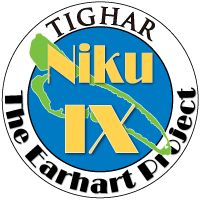
|
|
